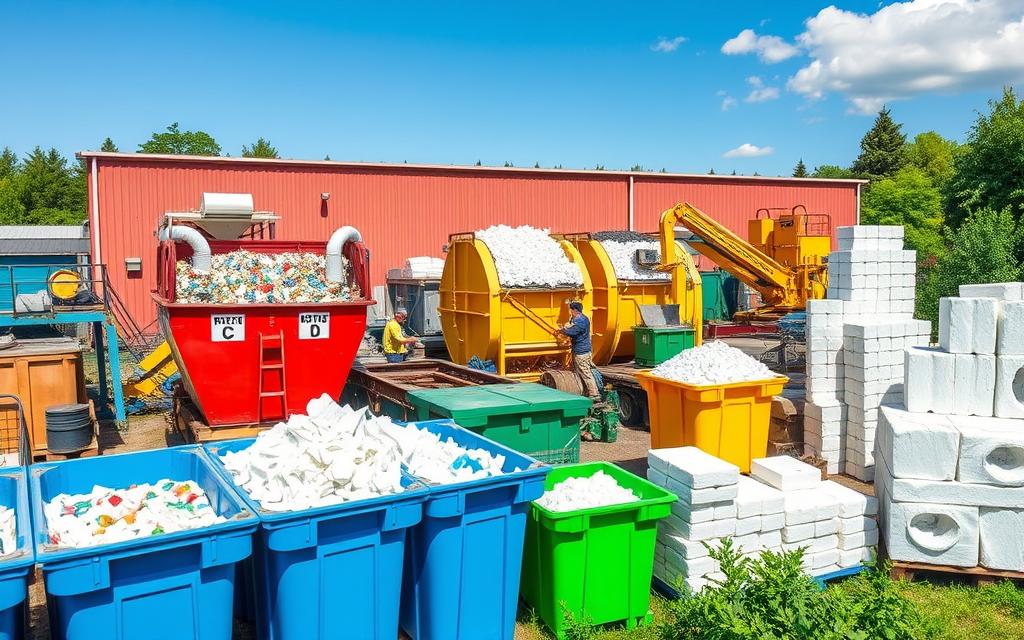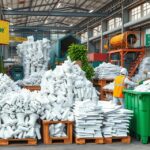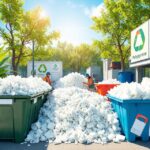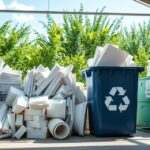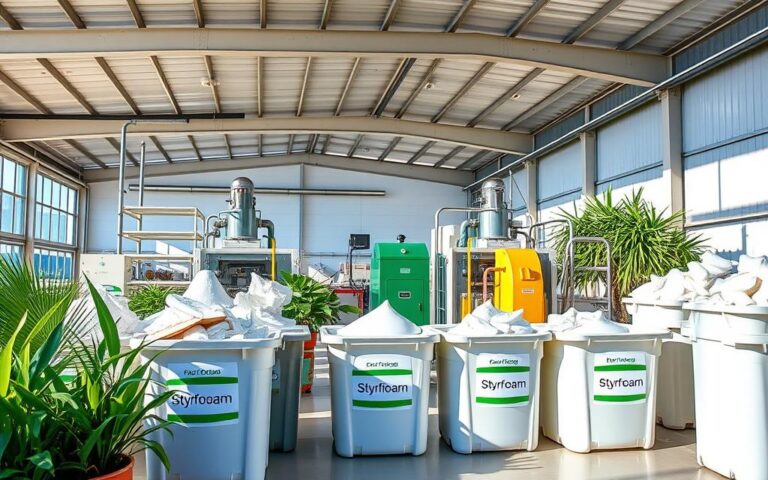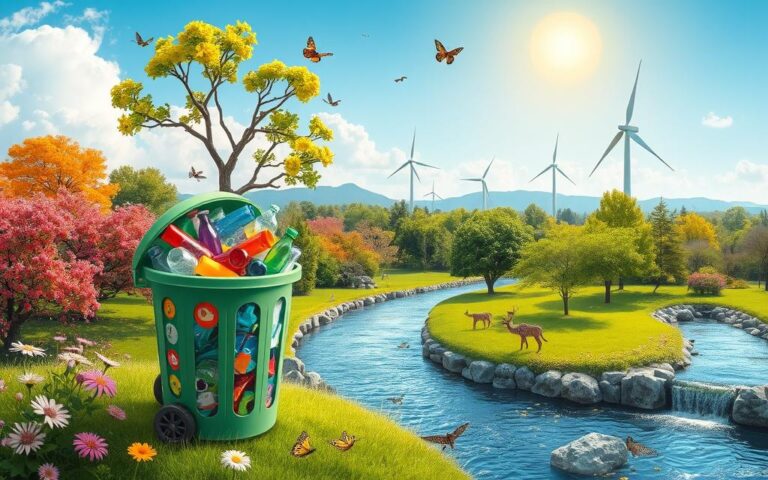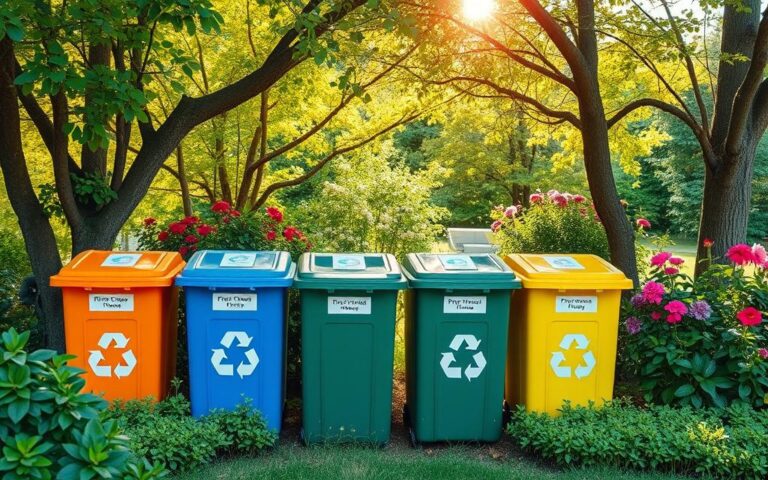Is Polystyrene Recyclable in the UK? Regulations and Options
Polystyrene is a lightweight plastic used a lot in the UK. It’s found in packaging, insulation, and disposable containers. Yet, only 1-2% of it is recycled here. It’s not usually collected in regular recycling bins.
However, businesses can get it recycled through special waste removal services. The Expanded Polystyrene Group says more than half of Expanded Polystyrene packaging is recycled. UK businesses handle thousands of tonnes of it every year from commercial waste.
Key Takeaways
- Only 1-2% of polystyrene waste is recycled in the UK, with the majority ending up in landfills or incinerators.
- Polystyrene is not typically collected in regular kerbside recycling, but businesses can arrange for dedicated recycling collection.
- Over half of all Expanded Polystyrene packaging is recycled in the UK, according to the Expanded Polystyrene Group.
- The UK has no large-scale polystyrene recycling facilities, leading to waste exports being common.
- The latest legal waste act in the UK (EPA 2021) introduced Extended Producer Responsibility (EPR), holding businesses accountable for the end-of-life environmental impact of products containing polystyrene.
Understanding Polystyrene and Its Types
Polystyrene is a versatile plastic material with different forms. Each form has its own properties and uses. Knowing about these types is key for recycling and disposal.
General-Purpose Polystyrene (GPPS)
General-Purpose Polystyrene (GPPS) is clear and hard. It’s used for things like disposable cutlery and CD cases.
Expanded Polystyrene (EPS)
Expanded Polystyrene (EPS), also known as Styrofoam, is light and foamy. It’s used for insulation and packaging. Every month, the UK recycles about 100 tonnes of EPS. This is because it’s mostly air and only 2% plastic.
Extruded Polystyrene (XPS)
Extruded Polystyrene (XPS), also called Styrofoam, is dense and hard. It’s mainly used for building insulation. XPS is made differently than EPS, with unique properties.
Other types of polystyrene include High Impact Polystyrene (HIPS) and Syndiotactic Polystyrene (SPS). Each has its own uses and features. Knowing about these types helps with recycling and disposal.
| Polystyrene Type | Key Characteristics | Common Applications |
|---|---|---|
| General-Purpose Polystyrene (GPPS) | Transparent, rigid | Disposable cutlery, CD cases, packaging |
| Expanded Polystyrene (EPS) | Lightweight, foam-like | Insulation, packaging |
| Extruded Polystyrene (XPS) | Dense, rigid foam | Construction insulation |
“Polystyrene is a versatile plastic material that can be found in various forms, each with its own unique properties and applications. Understanding these different types is crucial for effective recycling and disposal strategies.”
Is Polystyrene Recyclable UK: Current State and Regulations
The recycling of polystyrene in the UK is a big challenge. Some places collect it, but it often ends up in landfills. This is because there aren’t many places in the UK that can recycle it on a large scale.
But, the government is taking steps to tackle plastic waste. The Environmental Protection Act 2021 introduced Extended Producer Responsibility. This means companies must deal with the waste their products create, including packaging like polystyrene.
The UK government also has a Plastic Packaging Tax. It charges over £200 per tonne for plastic packaging that doesn’t have at least 30% recycled content. This tax aims to encourage businesses to use more eco-friendly packaging.
Despite these efforts, recycling polystyrene in the UK is still tough. Companies are advised to use waste balers to make polystyrene easier to recycle. Schemes like the Co-operative soft plastics recycling scheme and the Recycle at Boots scheme also help by accepting hard-to-recycle plastics, including some types of polystyrene.
The UK is working to improve its UK recycling regulations and polystyrene waste management. The journey towards a greener future with Extended Producer Responsibility and the Plastic Packaging Tax is ongoing. It has its ups and downs, but there’s hope for the future.
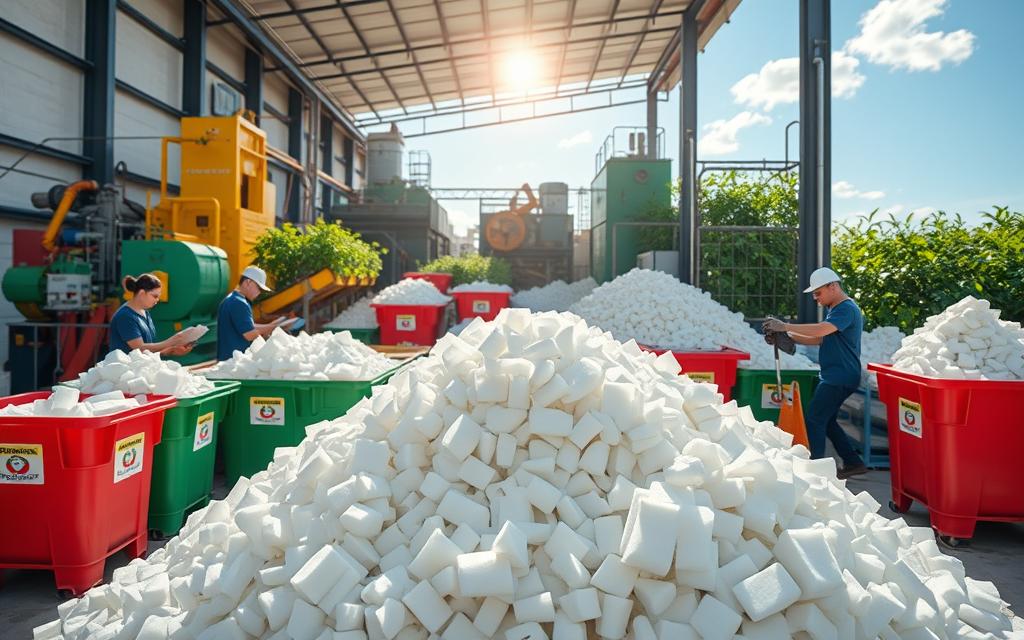
“Participation in initiatives such as Plastic Free July with 250 million people worldwide is encouraged to reduce plastic waste and promote sustainable habits.”
Challenges in Polystyrene Recycling
Recycling polystyrene, a common plastic, has big hurdles. One major problem is polystyrene contamination. Food leftovers and mixed materials can spoil the recycling process.
Transporting and storing polystyrene is also tough. Its lightness makes it easy to blow away, making waste management hard. It also takes up a lot of space, making storage and transport tricky.
Economic Barriers to Recycling
There are big economic hurdles to recycling polystyrene. The lack of recycling facilities and the high cost of recycling make it less appealing. Every year, 15.6 million tonnes of polystyrene is made, but only 12% is recycled, says the Alliance for Foam Packaging Recycling.
- Studies show polystyrene makes up 30% of landfill waste and 20% of litter.
- It takes over 500 years to decompose, which is a big environmental problem.
- Recycling polystyrene can help reduce carbon emissions and reach zero-waste goals.
- Companies can earn up to £500 per tonne by selling recycled polystyrene.
Despite these challenges, new solutions and partnerships are coming up. They aim to make recycling polystyrene more sustainable and circular.
Alternative Solutions and Best Practices
As worries about polystyrene packaging’s environmental impact rise, companies are looking for new ways to cut down waste. They’re turning to biodegradable and dissolvable packaging as a greener choice than traditional polystyrene.
Businesses are also getting better at recycling and reusing polystyrene. They’re using balers to pack it tightly, making it easier to store and move. Some, like Molygran near Manchester, have started their own recycling programs. They turn expanded polystyrene (EPS) into briquettes for reuse.
Recycled polystyrene can be used in many ways, like insulation in buildings or as protective packaging. It can even be turned into ‘wood’ for outdoor furniture. By trying out these new options and cutting down on waste, companies can lessen their environmental harm. They help the circular economy too.
| Key Facts | Benefits |
|---|---|
| Expanded Polystyrene (EPS) is 100% recyclable | EPS has an Ozone Depletion Potential (ODP) of zero |
| EPS is comprised of 98% air | EPS insulation helps in minimising heat transfer |
| EPS manufacturing process uses minimal energy through steam and pressure | EPS insulation in buildings aids in lowering energy bills and emissions |
As the need for eco-friendly packaging grows, businesses need to keep up. They should look into polystyrene alternatives, cut down on waste, and follow the circular economy principles. This way, they can reduce their environmental impact and lead in sustainable packaging.
Conclusion
Polystyrene recycling in the UK is facing big challenges, but progress is being made. This is thanks to new solutions and government rules. Businesses are key in boosting recycling by using the best methods and finding green alternatives to polystyrene products.
The future of managing polystyrene waste in the UK looks bright. It depends on better recycling systems, strong policies, and green packaging options. As people become more aware and technology improves, recycling polystyrene will become easier and more common.
The UK’s environmental plans are helping to shift towards a circular economy. This means seeing polystyrene waste as a valuable resource, not just trash. By adopting green waste management, the UK can cut down on landfill use and lessen polystyrene pollution’s harm.
The way forward for polystyrene recycling in the UK is through teamwork. Industry, government, and consumers must work together. By tackling the problems and using polystyrene’s benefits, the UK can achieve a greener future. This future will show the true value of this versatile material.
FAQ
What is the recycling rate of polystyrene in the UK?
In the UK, only 1-2% of polystyrene is recycled. It’s not usually collected in regular recycling bins.
What types of polystyrene are there?
There are many types of polystyrene. These include General-Purpose Polystyrene (GPPS), Expanded Polystyrene (EPS), and Styrofoam. Also, High Impact Polystyrene (HIPS) and Syndiotactic Polystyrene (SPS) are types.
How can businesses recycle polystyrene?
Businesses can get polystyrene recycled by contacting licensed waste companies. Some, like Molygran near Manchester, recycle EPS into briquettes for reuse.
What are the challenges in polystyrene recycling?
Recycling polystyrene is hard due to food contamination and mixed materials. It’s also light, making it hard to store and transport. There are also economic and safety issues, like the presence of styrene, a suspected carcinogen.
What alternatives are businesses exploring?
Companies are looking at biodegradable and dissolvable packaging. They also use polystyrene balers to make waste easier to handle.
How is the UK government addressing polystyrene waste?
The Environmental Protection Act 2021 introduced Extended Producer Responsibility (EPR). This makes companies responsible for their products’ environmental impact. The UK is also introducing the Plastic Packaging Tax to cut down plastic waste.

